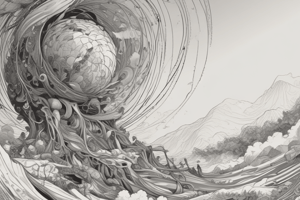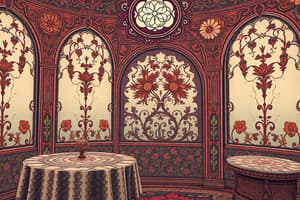Podcast
Questions and Answers
What is the definition of contrast?
What is the definition of contrast?
- A noticeable difference between two things (correct)
- Using analogous colors for interest
- The most important part of a composition
- Combining elements to create diversity
What is the purpose of emphasis in art?
What is the purpose of emphasis in art?
- To give importance to a feature (correct)
- To create noticeable differences
- To combine elements of art
- To diversify art elements
How is variety used in a composition?
How is variety used in a composition?
By combining elements of art to achieve intricate relationships.
How can contrast be used in a composition?
How can contrast be used in a composition?
How can emphasis be demonstrated in a composition?
How can emphasis be demonstrated in a composition?
How is variety demonstrated in a composition?
How is variety demonstrated in a composition?
List ways different elements of art can create emphasis.
List ways different elements of art can create emphasis.
Identify ways to create contrast in a composition.
Identify ways to create contrast in a composition.
Who is the artist of 'Two Young Girls at the Piano'?
Who is the artist of 'Two Young Girls at the Piano'?
What is the significance of 'Haystacks (Snow Effect)'?
What is the significance of 'Haystacks (Snow Effect)'?
What does 'Fin d'Arabesque' emphasize?
What does 'Fin d'Arabesque' emphasize?
Flashcards are hidden until you start studying
Study Notes
Principles of Art: Contrast, Emphasis, and Variety
-
Contrast:
- Defined as a noticeable difference between two elements (e.g., black vs. white, hot vs. cold).
- Used to excite, emphasize, and direct attention to key areas in a composition.
-
Emphasis:
- Prioritizes and gives dominance to specific features of an artwork.
- Helps focus viewer attention on the focal point, enhancing its importance within the composition.
-
Variety:
- Involves combining different art elements to create complex relationships.
- Increases visual interest through diversity and change in the artwork.
Discussion on Compositional Techniques
-
Contrast in Composition:
- Explore ways contrast can create depth and highlight crucial elements within the artwork.
-
Emphasis in Composition:
- Analyze how emphasis can be achieved through color, size, and placement to guide viewer focus.
-
Variety in Composition:
- Discuss methods artists use to incorporate variety, enhancing the work's visual complexity.
Demonstration and Identification
-
Techniques for Creating Emphasis, Contrast, or Variety:
- Review multiple artistic techniques that can be applied to achieve these principles in various compositions.
-
Identifying Principles in Artworks:
- Practice recognizing areas within compositions that exemplify emphasis, contrast, or variety.
Practical Applications
- Creating Emphasis, Contrast, or Variety:
- List the different elements of art (e.g., line, color, texture) that can be manipulated to achieve these effects.
Notable Artworks
-
Two Young Girls at the Piano (Auguste Renoir):
- Notable for its use of color and light.
- Emphasis is placed on the girls, creating a focal point in the composition.
-
Haystacks (Snow Effect) (Claude Monet):
- Features subtle variety in brush strokes that impart motion and visual interest.
- Employs analogous colors and similar values for cohesion.
-
Fin d'Arabesque (Edgar Degas):
- Showcases contrast between colors and light, emphasizing the ballerina with strong and implied lines.
Studying That Suits You
Use AI to generate personalized quizzes and flashcards to suit your learning preferences.




